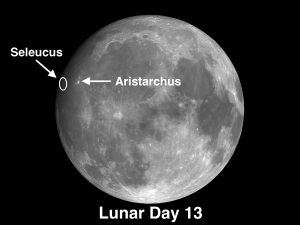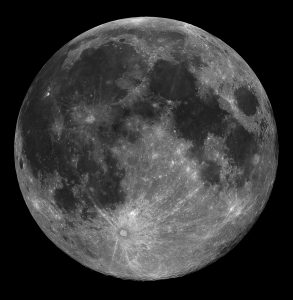[Last week it was suggested that you observe Maurolycus on Monday. Although Maurolycus was just east of the terminator, its rim mountains are so high that its floor was still in shadow. Tuesday would have been a better day to observe this fascinating crater. I will re-post the information on Maurolycus the next time it swings into view.]
The week of December 12-18 takes us from Lunar Day 13 to Day 19. Full Moon occurs on Tuesday evening. This week we will highlight the crater Seleucus (on Monday) and details on the full moon on Tuesday.
 Seleucus:† [NW/G3] Seleucus is an admirable little 27-mile crater sitting by itself on the Procellarum lava plains west of Aristarchus and Herodotus. It has a central bump aspiring to be a mountain, a sharply defined ejecta blanket, and terraced walls that rise to more than 10,000 feet.
Seleucus:† [NW/G3] Seleucus is an admirable little 27-mile crater sitting by itself on the Procellarum lava plains west of Aristarchus and Herodotus. It has a central bump aspiring to be a mountain, a sharply defined ejecta blanket, and terraced walls that rise to more than 10,000 feet.
 Full moon generally occurs around the end of Day 14, but this can vary by up to 12 hours, so full moon could happen on Day 15. To be strictly technical, we never actually see a full moon. Such an object must be exactly opposite the Sun from the Earth; it would therefore be in the Earth’s shadow and we would be in the grips of a lunar eclipse. What we call a full moon must, of necessity, be placed above or below the Earth’s shadow (making it slightly less than full). The result is that some craters will always show a bit of shadow relief. Take a look at the Moon now and decide whether it is sailing above or below the Earth’s shadow. The most eye-catching features of the full moon are the systems of rays surrounding Tycho, Copernicus, and Kepler.
Full moon generally occurs around the end of Day 14, but this can vary by up to 12 hours, so full moon could happen on Day 15. To be strictly technical, we never actually see a full moon. Such an object must be exactly opposite the Sun from the Earth; it would therefore be in the Earth’s shadow and we would be in the grips of a lunar eclipse. What we call a full moon must, of necessity, be placed above or below the Earth’s shadow (making it slightly less than full). The result is that some craters will always show a bit of shadow relief. Take a look at the Moon now and decide whether it is sailing above or below the Earth’s shadow. The most eye-catching features of the full moon are the systems of rays surrounding Tycho, Copernicus, and Kepler.
Look at the “straits” between Mare Imbrium and Oceanus Procellarum. Can you see that the color of the lava in both areas is different? This is a clear indication that the lava flows came from different sources at different times. Also notice the darker ring surrounding Mare Serenitatis, particularly along the eastern and southern shores. It is more conspicuous now that we are at full moon. After the Serenity Basin formed, it was covered by darker titanium-rich lava that also caused the basin to sink and open up arcuate cracks along the southern shore. A second, lighter colored lava flow appeared much later, but because this flow did not completely cover the floor of Serenity, it left the mare with a dark collar.
OF ADDITIONAL INTEREST ON AND AROUND THE MOON THE WEEK OF DECEMBER 12-18:
There’s a special treat in store for Monday evening: the Moon will occult Aldebaran — visible from nearly all of North America. The occultation will begin after 11:00 PM for the east coast, around 8:20 for Denver, and 7:00 for Los Angeles.
Also, the Geminid meteor shower occurs late on Tuesday. Unfortunately it coincides with the full moon; however, the Geminids have frequent fireballs. Look in a direction away from the glare of the full moon.
======================
It is highly recommended that you get a copy of Sky and Telescope’s Field Map of the Moon, the very finest Moon map available for use at the telescope. It is available for $10.95 at www.skyandtelescope.com and on Amazon. All features mentioned in this blog will be keyed to the grid on the Field Map and will look like this: Plato: [NW/D9]
Credits:
Courtesy of Gray Photography of Corpus Christi, Texas
Lunar photos: NASA / USGS / BMDO / LROC / ASU / DLR / LOLA / Moon Globe. Used by permission
- Rupes Cauchy: A Best Known Fault on the Moon - July 22, 2024
- Moon Crater Schickard – Crater Floor has Stripes - July 15, 2024
- Moon Craters Langrenus and Vandelinus - July 8, 2024